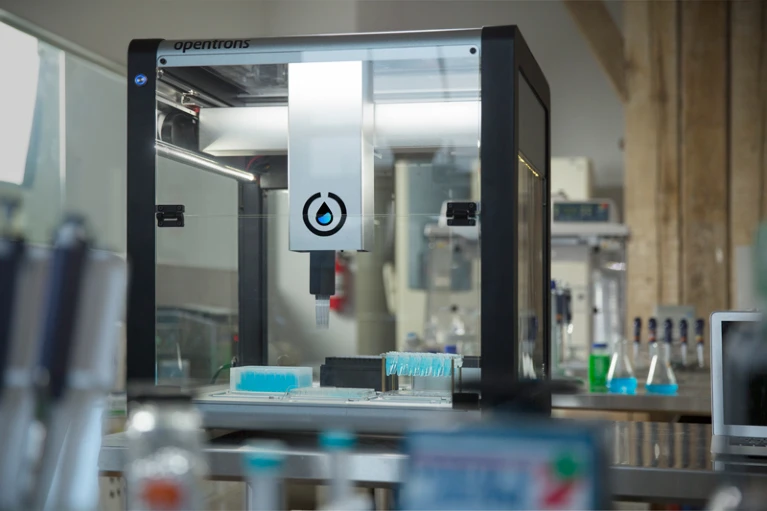
Cytera Cellworks makes automated devices to make the error-prone and labor-intensive aspects of cell culture like media replenishment, passaging, and imaging quicker as well as more sterile. We talked to Dr. Xian Weng Jiang, Cytera’s Head of Biology, about how the OT-2 aids their own laboratory automation.

Dr. Xian Weng Jiang in his lab with his OT-2. CREDIT: Dr. Xian Weng Jiang.
OPENTRONS: Please tell us a little about your background.
XIAN WENG JIANG: I am a biologist by training but have moved into biotechnology and regenerative medicine. I got my Ph.D. in nanomedicine for developing nanoparticles for cancer therapy. I spent some time working at a startup developing systems for blood diagnostics; I was a study director in their method development and validation team. This past April I came to Cytera—the same time as our OT-2.
OPENTRONS: What’s a typical day in the lab for you?
XIAN WENG: We run mostly cell-based assays that are comparable to manual experiments. We assess metabolic status, growth, and the expression of surface markers. We make cell culture automation that works with our customers’ existing T-flasks and incubators. Ultimately, we aim to have every part of these assays automated.
OPENTRONS: What specifically do you use the OT-2 to do, and how does it fit into your workflows?
XIAN WENG: Since Cytera makes automated cell culture systems, the OT-2 comes in when we run our assays. We use the OT-2 to run four different assays to check our system and make sure nothing negatively impacts the cells. These assays are always the same regardless of which cells we input: we measure cell viability, cell respiration, metabolic activity, and membrane integrity.
When we started at Cytera, we had to run all these same assays by hand. It was a waste of time to run them over and over and over again that way. We’re a startup, so it made no sense to do that when we could have the OT-2 robot handle all of the repetitive work.
The OT-2 is very handy for me. The only manual step is transferring tubes into the OT-2; I just put the tubes in and press “Go.” It fits into our workflows very well, and I don’t think it’s very different from how other Opentrons customers would use the OT-2 for cell-based assays.
OPENTRONS: What was it like to get your Opentrons robot up and running?
XIAN WENG: I previously built and worked with gantry-based systems as liquid handling devices in other labs, so I had expectations for what setting up the OT-2 system would be like. Setting up the OT-2 robot was easy and straightforward.
OPENTRONS: Had you used any lab automation before your OT-2?
XIAN WENG: Yes: I have designed, coded, used, and built automated systems before. Specifically, I modified a benchtop 3-Axis CNC router with a custom dispensing tip connected to a high-precision syringe pump. We used it to perform ELISA-based assays.
OPENTRONS: What else is good or bad about your OT-2?
XIAN WENG: Our automation isn’t pipette-based—we have our own nozzle that we designed—so our usage is a bit different. But the OT-2 has made it very easy to transfer the concepts of the protocols. I don’t need to get a protocol from a kit, because the robot handles the samples exactly how you would handle a pipette. Even the software is very intuitive; it is easy to step in and use it.
OPENTRONS: Are you planning any other automation?
XIAN WENG: From an application standpoint, right now, Opentrons is an open-source system. The way we use it there’s a manual part where I have to move the cells into the system. We are hoping that further down the line our system will talk to the OT-2 and reduce hands-on time by removing this human intervention between the two systems. I foresee this being a fairly simple integration.
Interview edited for length and clarity.